Are you feeling BORED of seeing the SAME flowers in your garden? Need a LITTLE change in your OUTDOOR space? Then why not try these various types of daisies?
At AsterGardening, we’re all about making your GARDEN AWESOME. That’s why we’ve created a GUIDE to help you up your FLOWERS game.
We’ve got EXPERTS who put together a complete guide on types of daisy. These BLOOMS will surely make your garden look STUNNING!
Get ready to discover the beauty of these ADORABLE flowers. We’ll be here to GUIDE you every step of the way!
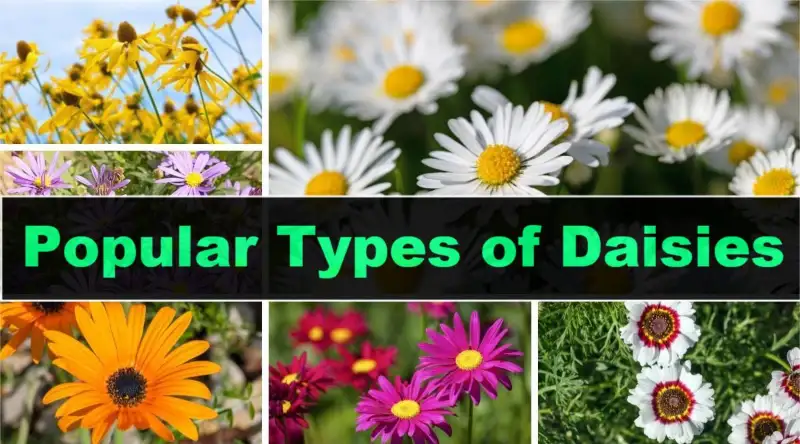
Are daisies a perennial plant?
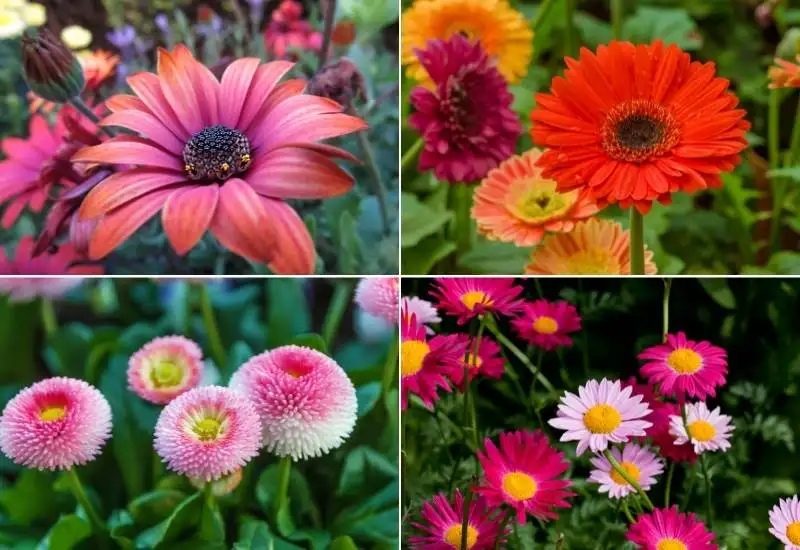
WANNA know if daisies are a PLANT that comes back EVERY year? Well, it DEPENDS on where you live.
Daisies can be annual and perennial, based on the USDA zone where they GROW. They can’t survive the HARSH winter (zones 1-6), so they grow ANNUALLY.
But daisies can return yearly with proper care if you live in WARMER zones (7-11).
Even if you live in a COLDER zone, you still GROW them as ANNUALS by planting them in the spring.
This way, you ENJOY their blooms until the first frost. How cool is that?
How many colors of daisies are there?
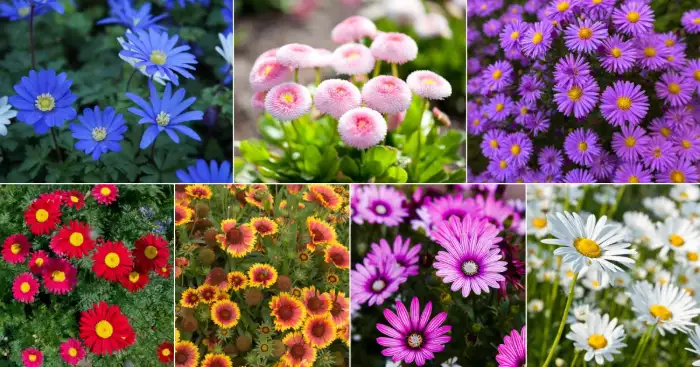
Daisies are EVERYWHERE, right? But did you know there are over 2300 species of daisies out there? That’s a LOT of daisies!
And guess what?
Each one MIGHT have a different color. So, how many COLORS are there? Think BIG!
Well, the most common colors are white, yellow, and pink. But that’s not ALL! Daisies can also be red, bright orange, purple, and EVEN blue!
As for my personal experience with daisies, I have seen WHITE and YELLOW daisies in my garden. They LOOK beautiful and ADD a touch of elegance to the garden.
Can you imagine a blue daisy?
That’s WILD! Plus, some daisies have BI-COLORED petals or a DARK center. It makes them even more UNIQUE and BEAUTIFUL.
Knowing about the colors of daisies is really helpful in CHOOSING the PERFECT one for the garden.
20 Popular Types of Daisies
Check out these 20 types of daisies that’ll BRIGHTEN your planting space. You’ll love the way they brighten up your OUTDOOR space!
1. Aster Daisy
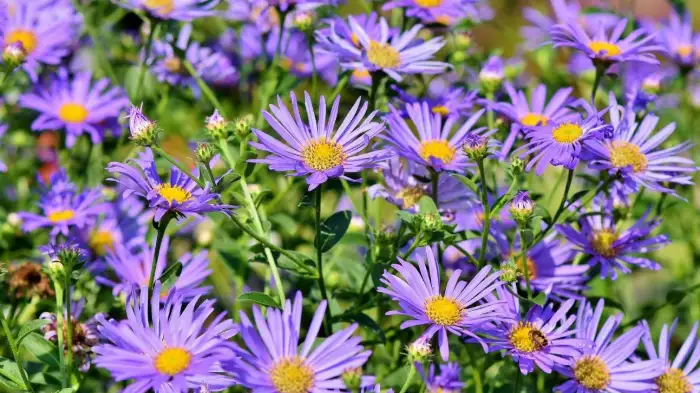
Aster daisies (Michaelmas daisies) are FROM North America and Europe. They are AVAILABLE in pink, purple, blue, and white colors. Pretty neat.
Aster daisies can BLOOM in the late summer and fall, even after other daisy flowers have stopped.
Planting some aster daisies? REMEMBER, they like well-draining soil and full sun to grow 1-3 feet tall.
You can GROW them in USDA hardiness zones 4-8. And REMEMBER to give them water and fertilizer to keep them happy and healthy.
If you PRUNE them at the START of the spring, you’ll help them grow even more!
2. Blue-Eyed African Daisy

Blue-Eyed African Daisies (Arctotis) are native to South Africa. It can HANDLE zones 9-11 like it’s no big deal; IMPRESSIVE!
These daisy flowers have blue or purple centers. The PETALS are bright white or yellow that pop out DURING the day.
Blue-Eyed African Daisies can grow near the coast. They are DROUGHT TOLERANT and can handle the SALTY air like a boss.
Taking CARE of them is super easy. Give them a deep drink of water occasionally, but only a few times.
GIVE them a little early spring trim if you WANT them to be even more awesome.
3. Blushing Daisy

Let’s talk about the Blushing Daisy or Townsendia if you wanna be FANCY. These guys are North American NATIVES and are SMALL.
But don’t let their size fool ya.
They PACK a punch with pink or lavender petals that BLOOM in the spring and summer.
If you’re thinking of growing Blushing Daisies, ENSURE they get full sun and the soil is nice and drained.
They’re GOOD to go if you’re in USDA hardiness zones 8-11. I recommend Blushing Daisies for rock gardens or small spaces.
4. Chocolate Daisies

Chocolate Daisies (Berlandiera lyrata) are SUPER COOL daisy flowers. They are NATIVE to the Southwestern US and Mexico and smell like chocolate – YUM!
These LOVELY flowers have BRIGHT yellow petals with brown CENTERS. They bloom during the summer season.
They can GROW in USDA hardiness zones 4-9 and reach 1-2 feet tall. Remember to water them DEEPLY but not too OFTEN – they don’t like to be DROWNED!
Also, remove the faded flowers (deadheading) to ENCOURAGE more blooms.
I SUGGEST adding a layer of mulch to help the soil RETAIN moisture – your Chocolate Daisies will thank you for it!
5. Coneflower Daisy

Want to LEARN about beautiful flowers that are also GREAT for your health? MEET the Coneflower Daisy, aka Echinacea!
It’s a real beauty native to North America and famous for various reasons. COOL, right?
The Coneflower Daisy is WELL-KNOWN for its immune-boosting powers. So if you want to give your immune system extra love, this flower is the ticket!
One of the MOST POPULAR Coneflower Daisies is the Magnus cultivar. Its PINK petals and BIG ol’ center cone make it a real showstopper.
It can GROW in USDA zones 3-9, so many folks can ENJOY this lovely plant.
6. Crown Daisy

Crown Daisy is a beautiful flower that COMES from the Mediterranean region. This PRETTY LITTLE flower also goes by the NAME Chrysanthemum coronarium.
Crown Daisies are easy to care for and look amazing in any flower garden, from my EXPERIENCE.
These SHOWY flowers LOVE soaking up some sunshine but are okay with partial shade. They must be PLANTED in well-draining soil.
One of the coolest things about Crown Daisies is that they BLOOM for a long time. They’re TOUGH plants and can GROW in a range of USDA zones from 2 to 11.
7. Cape Daisy
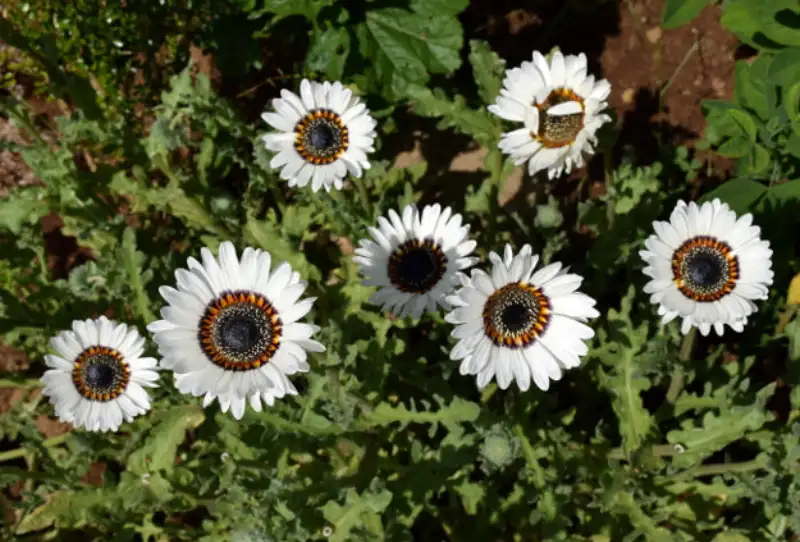
Cape Daisy is SERIOUSLY one of the most attractive flowers out there! They go by Osteospermum, a PRETTY fancy name (don’t you think?).
Anyways, this beauty is native to South Africa. Check out the Pink Whirls – those pink and white petals are to DIE for!
They love full sun basking in well-draining soil to THRIVE. But get this – they’re also DROUGHT-TOLERANT.
Cape Daisies are super hardy plants and can GROW in USDA zones 9-11. They ATTRACT butterflies and other pollinators.
8. Cream African Daisy

Cream African Daisy is native to southern Africa. It’s also KNOWN as Dimorphotheca, which sounds FANCY but doesn’t let that INTIMIDATE you.
Their flower heads come in different types. The MOST POPULAR types are Dune Tansy with its CREAMY petals and the White Drift with white petals.
The best part?
These BEAUTIES are chill REGARDING water, perfect for rock gardens or borders.
Plus, they’re tough cookies and can HANDLE a bit of heat. If you live in USDA zones 8-11, you’re LUCKY – this plant can HANDLE your weather!
9. Desert Star Daisy

So you want to know about the Desert Star Daisy? This LITTLE plant (psilocarphus tenellus) is from the Western United States.
The Desert Star Daisy is DELICATE, with feathery LEAVES and bright yellow FLOWERS.
It’s a great plant for rock gardens, containers, or borders – it ADDS a pop of color! Plus, it can HANDLE drought conditions like a BOSS.
They can grow in USDA growing zones 4-9.
Do you need cultivar SUGGESTIONS? Check out the golden yellow cultivar GOLD NUGGET or the white one called SNOW CROWN.
10. Dahlberg Daisies

Dahlberg Daisy (thymophylla tenuiloba) is native to the southwestern United States and Mexico.
This LITTLE beauty is an annual, self-seeding PLANT. It SPROUTS up BRIGHT yellow flowers from spring to fall. How cool is that?
The BEST part is that these daisies are PERFECT for borders, rock gardens, or containers. The USDA growing zones suitable for this plant are 9-11.
As a GARDENER, I highly recommend planting Dahlberg Daisies. THE REASON? Because they’re EASY to take care of and ADD a cheerful touch to any garden.
Trust me, these little guys THRIVE in areas with full sun and don’t NEED much watering.
11. English Daisies
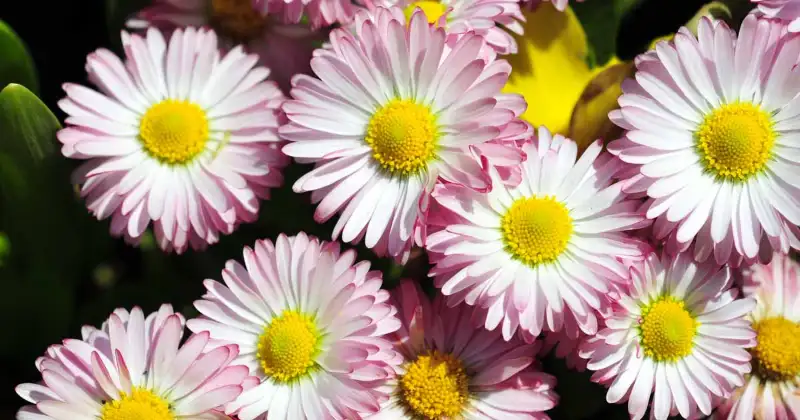
English Daisy (lawn daisy) is a super popular species of the daisy family. It COMES in white, pink, or red colors and has a bright yellow CENTER.
They’re also CALLED Bellis perennis – pretty cool, right? English Daisies ORIGINALLY came from western, central, and northern Europe.
This classic daisy flower loves cooler temperatures and well-drained soil with PARTIAL shade.
If you’re in the USDA growing zones of 4-8, you’re in luck! That MEANS you can totally GROW your English daisy.
Some POPULAR cultivars include Galaxy Mixed, Tasso Mix, and Habanera Mix. So cool, right?
12. Flame African Daisy
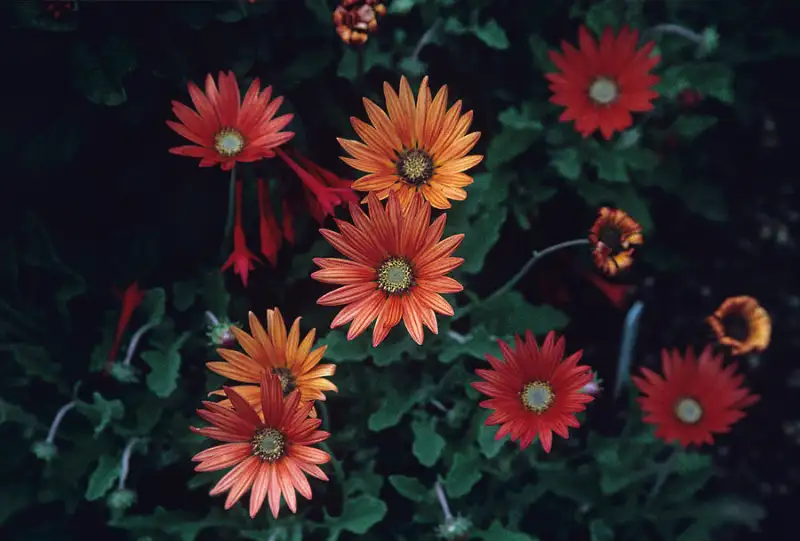
Flame African Daisy is a COOL type of daisy that COMES from South Africa.
These are super vibrant purple flowers. You can FIND them in yellow, orange, pink, purple, and white SHADES.
One of the best things about Flame African Daisies is that these daisies BLOOM from spring to fall. You get to ENJOY them for a good CHUNK of the year.
Flame African Daisies can grow in the USDA growing zones 9-11.
4D Pink, 4D Purple, and Serenity Bronze are POPULAR Flame African Daisy CULTIVARS. These BABIES will make your garden POP!
13. Florist’s Daisy

So, HAVE you HEARD of the Florist’s Daisy? It’s a pretty cool plant, also called the Shasta Daisy.
It has BEAUTIFUL white and yellow flowers with BRIGHT yellow centers. Who wouldn’t WANT that in their GARDEN?
And there are different kinds of Florist’s Daisies out THERE. Alaska has all-white flowers, and Becky has even BIGGER flowers and BLOOMS for longer.
I always have had good experiences growing them for aesthetics. My RECOMMENDATION is to GROW them in USDA growing zones 5-9.
14. Gaillardia Daisy
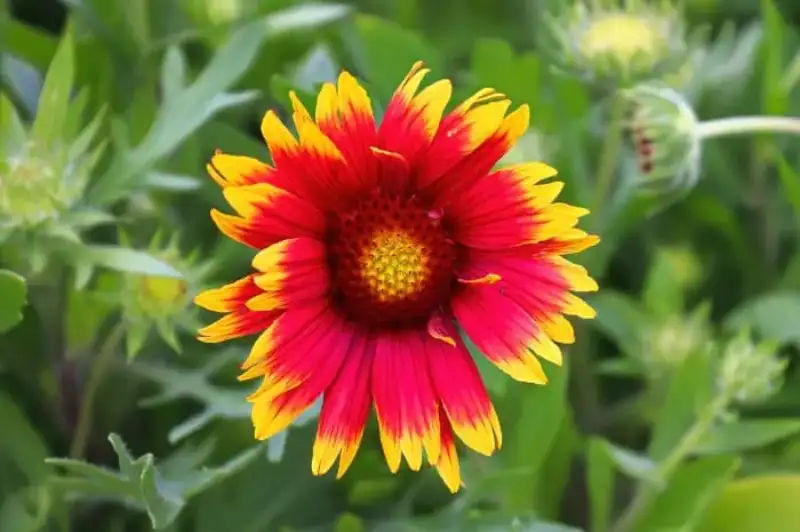
Gaillardia daisy, or the blanket flower, is a wildflower NATIVE to North and South America. It was first DISCOVERED by Spanish explorers.
One of the coolest things about the Gaillardia daisy is the COLORFUL petals. They COME in SHADES of red, orange, and yellow, with a DARK center that makes them pop!
Plus, they’re perfect for summer gardens because they BLOOM for a long time.
Want to grow them? I have a HOT tip: they LIKE well-draining soil and full sun. You can FIND them in USDA growing zones 3-10. Pretty neat?
15. Gerbera Daisy

Gerbera daisy, or African daisy, is ORIGINALLY from South Africa and was FOUND in the early 1800s.
Today, it’s a popular showy flower in your garden because of its BRIGHT colors and UNIQUE shape. They are PERFECT for cut flowers due to their AMAZING aesthetics.
Gerbera daisies have different cultivars, including pink, red, orange, yellow, and white. They also HAVE a dark center which ADDS a nice contrast.
Gerbera daisies can GROW up to two feet TALL and do well in USDA growing zones 9-11.
One of the REASONS I love Gerbera daisies is that they can HELP improve indoor air quality. I ADVISE you to grow them in an indoor garden.
16. Montauk Daisy
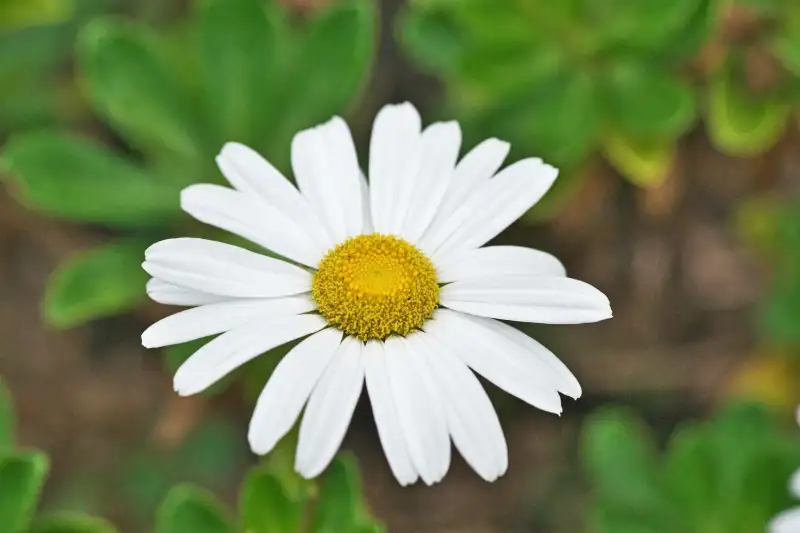
Montauk Daisy or Nippon Daisy COMES from Japan and Korea.
But guess what?
It MADE its way to the United States in the 1900s and is now a POPULAR garden plant.
One of the things that makes this daisy so cool is its big, beautiful white flowers blooming in the fall.
And GET this: there are DIFFERENT types of Montauk daisies too! One of the most POPULAR varieties is Summer Sun, which has yellow flowers and a dark CENTER.
They do best in USDA growing zones 5-9. And when they’re FULLY grown, they can REACH about three feet.
17. Marguerite Daisy
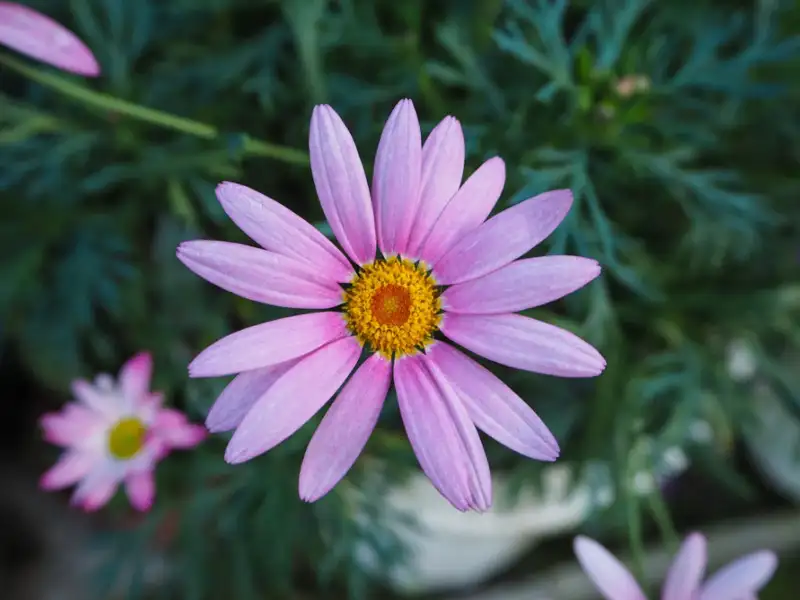
Marguerite daisies are super popular flowering plants that originally came from the Mediterranean.
They are also FAMOUS for the Paris daisy or blue marguerite daisy – FANCY? These plants COME in different colors, like dark yellow, white, and pink. COOL, right?
They are like glowing stars with bright white petals. Interesting, HUH?
Do you know what’s AWESOME about marguerite daisies? They’re really TOUGH! They can HANDLE a whole bunch of DIFFERENT temperatures.
Growing marguerite daisies in USDA growing zones 5-9. I BACK this with my experimentation with GROWING these over the years.
Remember to PROVIDE full sun and REGULAR watering for this ANNUAL plant.
18. Oxeye Daisies
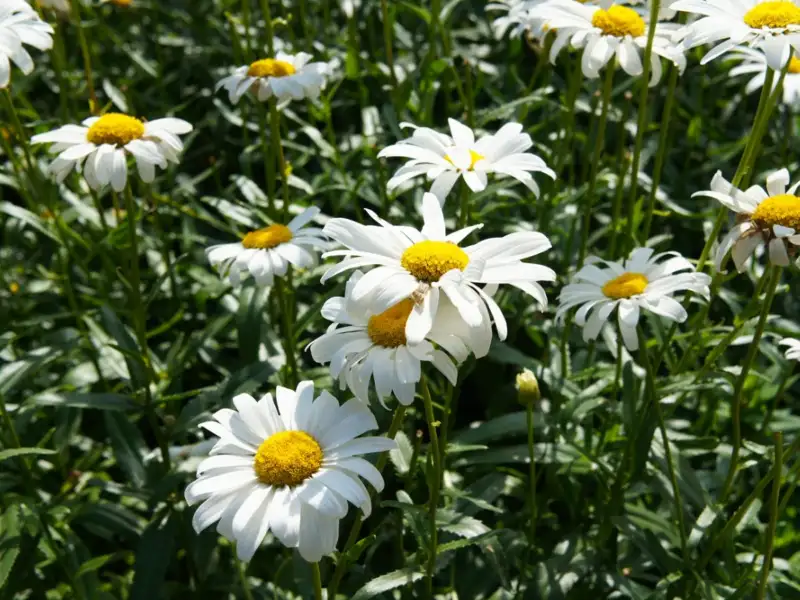
The Oxeye daisy is a cool flowering plant from Europe and Asia. You might also KNOW them as the common daisy or the dog daisy.
Did you KNOW these tiny flowers come in DIFFERENT colors? Some have PETALS with yellow centers!
Make sure you choose a spot with GOOD drainage and PLENTY of sunshine. They do BEST in USDA growing zones 3-7, so keep that in MIND.
One AWESOME thing about oxeye daisies is their BEAUTIFUL and almost magical-looking flowers.
They’re TOUGH little guys, too – you can find them GROWING on roadsides and in waste areas. They’re just that HARDY!
19. Painted Daisy
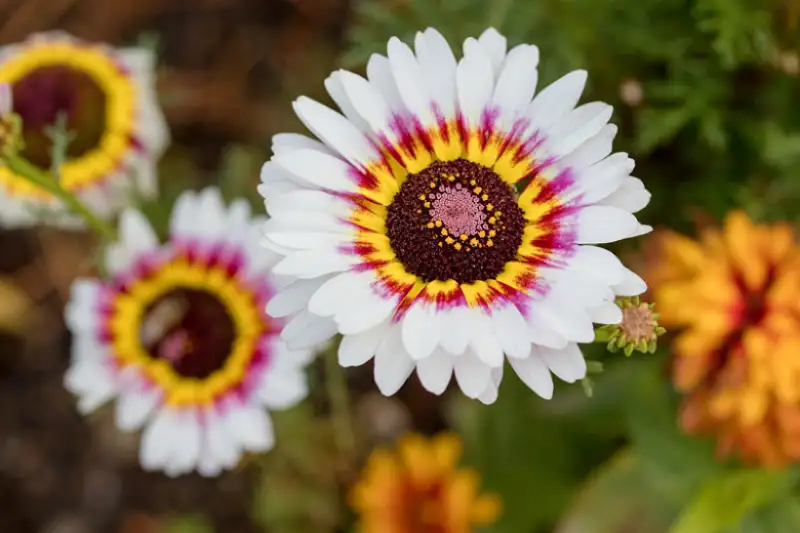
Did you know that painted daisies originally came from Asia and Europe? They COME in cool colors, like pink, red, and purple!
Pick a SPOT with well-draining soil and full sun to GROW this herbaceous perennial.
And keep in mind that they’re HAPPIEST in growing zones 4-9, according to the USDA. Their growth is OPTIMUM when GROWN in early summer.
These DELICATE flowers are a great choice to add COLOR to your garden. They have that classic daisy LOOK, which is super cute!
And if you’re into CUTTING FLOWERS to put in a vase, painted daisies are an all-star CHOICE.
20. Shasta Daisies

Want to add some North American charm to your garden? Why not PLANT some Shasta daisies WITH snow-white petals?
These BEAUTIES are named AFTER Mount Shasta in California. They COME in different colors, LIKE white and yellow, with a yellow center.
Pick a spot with full sun and well-drained soil to grow this herbaceous perennial.
REMEMBER that Shasta daisies GROW best in USDA growing zones 3-9.
But why stop at just admiring them in your garden?
These daisies make FANTASTIC cut flower bouquets for your HOME too! They ADD a touch of classic ELEGANCE to any room.
FAQs about Types Of Daisies
1. Is there a daisy that blooms all summer?
Yes, some daisies, like the Shasta and painted dais, can bloom throughout the summer. However, they need regular deadheading with enough water and nutrients. Frost can affect the growth period of daisies.
2. Do daisies like full sun or shade?
Daisies prefer full sun and require at least 6 hours of daily sunlight to thrive. However, some varieties, such as painted daisies, can tolerate partial shade. Read a manual for each variety to understand the light requirements better.
3. Should daisies be cut back after blooming?
Yes, daisies should be cut back after blooming. It helps promote bushier growth and more showy blooms. This can also help prevent disease and pest problems for most daisy varieties.
4. What is the lifespan of daisy?
The lifespan can vary depending on the daisy species and growing conditions. Most daisies are perennial if provided with proper care. Some cultivars may be short-lived, while others are long-lived.
What’s Next
So you LEARNED about daisies – they’re the bomb! These LITTLE flowers come in white, yellow, pink, red, and blue.
How cool is that?!
They LOVE full sun to partial shade. PROVIDE them well-drained soil, good watering, and SOME fertilization.
There are many types of daisies. Some FAMOUS ones are the Shasta daisy, Oxeye daisy, Marguerite daisy, and Painted daisy.
The best part?
Daisies are TOUGH and can LIVE for years, giving you many GORGEOUS summer blooms.
Hey there, PLANT-LOVER! Are your green friends causing you SOME trouble? Look no FURTHER; AsterGardening is here to SAVE the day!
We have COVERED you with AWESOME tips, expert advice, and solutions to COMMON plant issues!
